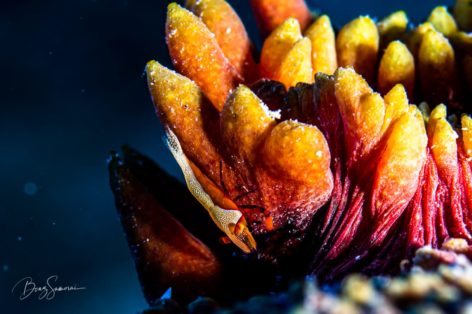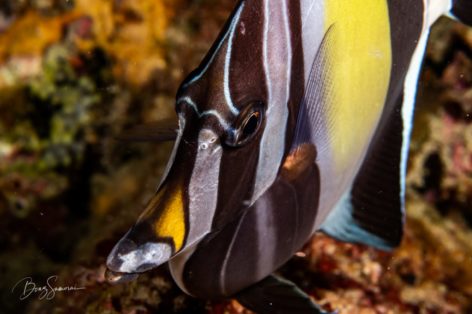World of Seychelles
Nudibranches Families
VARICOSA
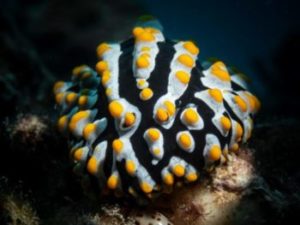
up to 7cm. All wart slugs are masters of chemical defense. When stressed in any way, they produce a pungent toxin. 🌎 No marine organisms are known to prey on this species 🌺 . They do not have gill plumes but have gill flaps distributed in the cavity between the foot and the mantle. When disturbed, some species will retract their gill plates. In case of threat, some produce a toxin and have no known predators, while others can escape the danger by swimming by undulation. These gastropods reproduce sexually, are hermaphroditic and oviparous. Male gametes are exchanged through a duct and fertilisation is internal.
SEA ROSE SEYCHELLES ( Spanish Dancer eggs)
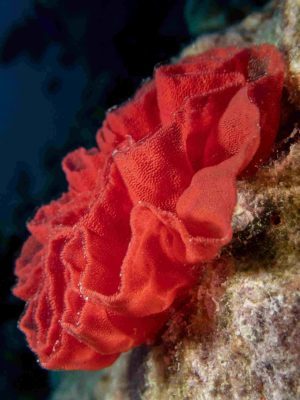
The Hexabranchus sanguineus have a unique reproductive trait about them. Spanish dancers are hermaphrodite organisms. After copulation, it may take moments or days before the Spanish dancer is ready to lay her eggs. When the female is ready she will lay her eggs on top of coral or on part of a rock, usually near her food source. She lays a ribbon-like structure with thousands of eggs forming what divers call ” SEA ROSE ” She does this so the eggs blend in with the coral, yet remain recognizable to her. Since the Spanish dancer eats toxic sponges, she can secrete her poison on to her eggs so that predators such as crabs, lobster and reef fish aren’t able to eat them. This also means that she will not have to sit over the eggs to protect them. Since their life expectancy is only one year, they will mature very fast.
SPANISH DANCER
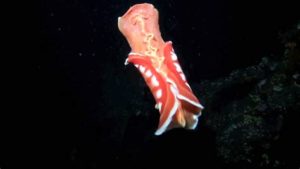
PHYLLIDIOPSIS KREMPF
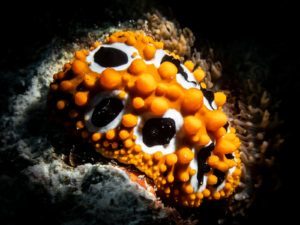
Up to 7cm. A very elongate genus member with brightly pink tubercles what fuse to form ridges on the body. Very variable specie. These molluscs live on shallow reefs where they feed, depending on the species, on ascidians and soft corals. The two front tentacles, the rhinophores, are chemosensitive sensory organs that detect odours and noise. Some nudibranchs have gill plumes used for respiration at the back of the mantle. If threatened, some produce a caustic toxin, so they have no known predators, while others can escape danger by swimming by undulation, or some species are capable of autotomy. These gastropods reproduce sexually, are hermaphroditic and oviparous.
PHYLLIDIOPSIS CARDINALIS
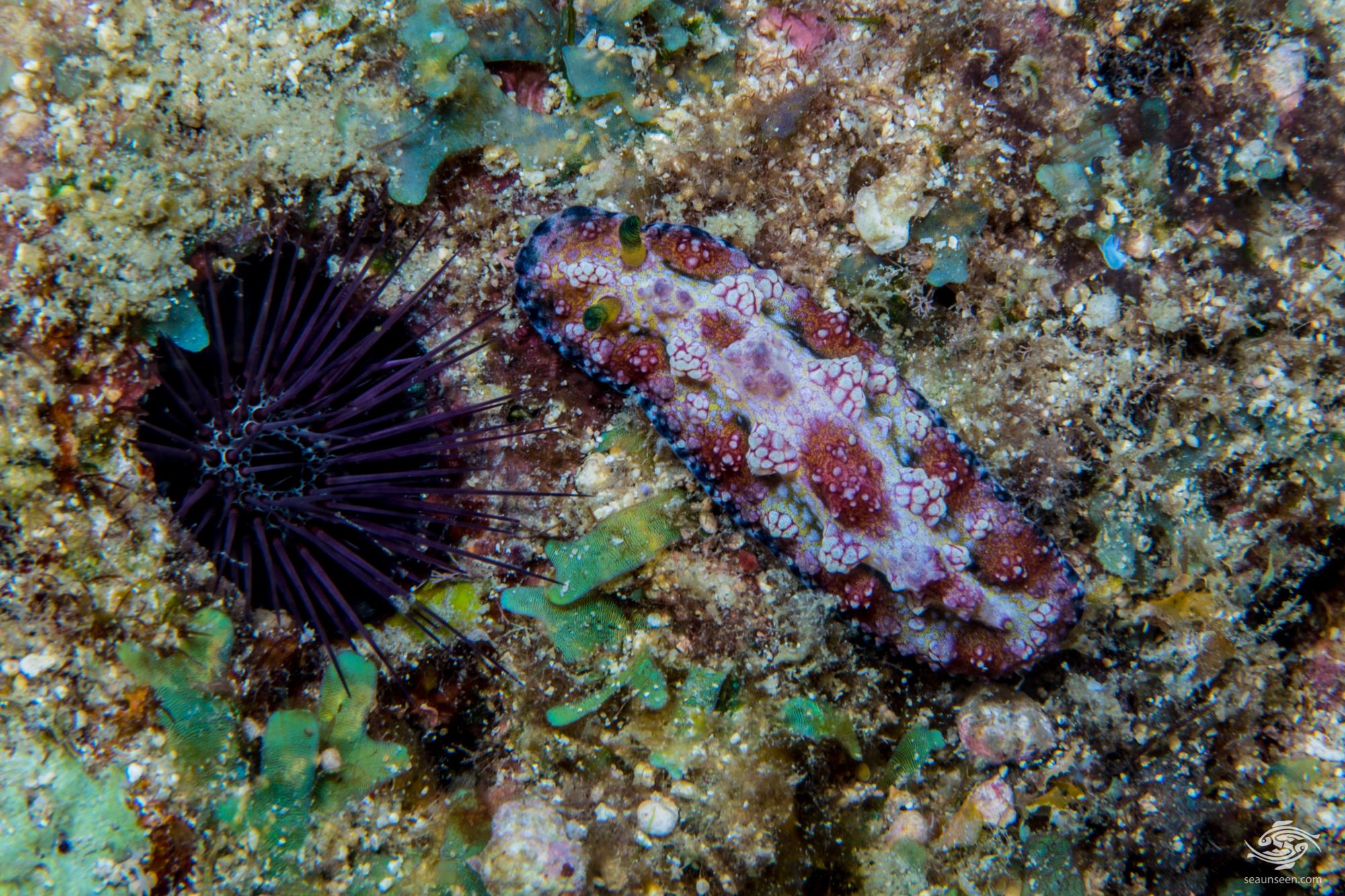
Phyllidiopsis cardinalis are the only known phyllidid with green rhinopores and is therefore quite easy to identify even as small juveniles. The colors vary quite dramatically and the juvenile specimens we have seen are much darker than the adults. This may just be coincidence however and further research is necessary. The body has a large number of globular tubercles across it, with two rough rows across the top of the body having the larger tubercles. The colours which are not uniform vary greatly in Tanzania from a dull purple to red, orange, pink and yellow. Interestingly the darker colours are usually spread around the outside of each specimen and most have lighter colours on the mid back. They grow up to 8 centimeters in length but they are usually smaller.
NEMBROTHA LINEOLATA
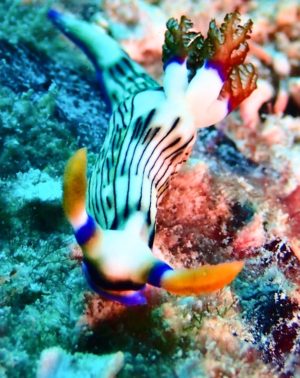
This nudibranch is characterised by an elongated body, very reduced skirt with a blue border. Its background colour is white to cream with a dark brown, longitudinal pattern of lines and dashes. The head has a horizontal V-shaped line, sometimes 2 to 3 small dashes above this line. The mouth tentacles are bright blue in colour. 5 cm max size, 20 m depth.
Found on coral reefs. Feeds on ascidians.
Reproduction: Sexual. It is simultaneously hermaphroditic and oviparous.
SUSANAE FLATWORM
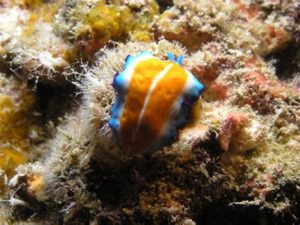
Up to 8 cm long, shows two clearly visible extensions at the front: the pseudotentacles.
The body is dotted with numerous golden to orange dots, although the size of the dots may vary and their shape may be less regular depending on the individual.
Sometimes, especially in small individuals (juveniles?), a more or less wide yellow-orange median line can be seen. It seems to persist in adults depending on the geographical area but is absent in other specimens.
The ventral side is pale mauve.
CHROMODORIS GEMINUS
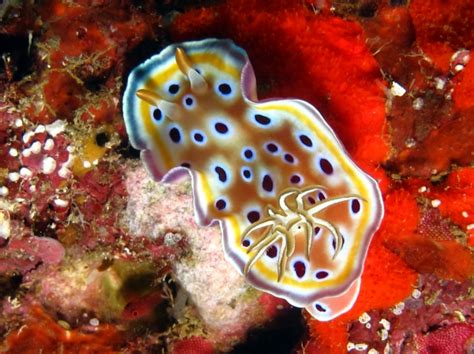
Up to 6cm. They all have large purple or purple-brown spots or marks, usually ringed with white, an often reticulate brownish background, and a purple border. Chromodoris geminus differs in having four colour bands around the mantle edge, an outermost white, then translucent greyish purple, then white, then yellow.
CHROMODORIS LOCHI
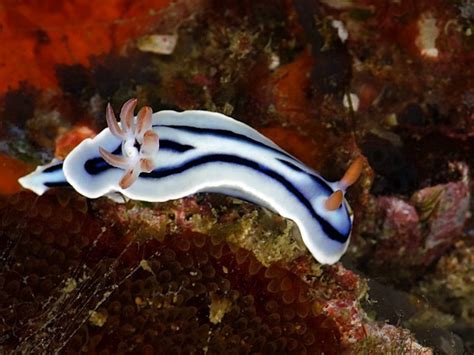
Up to 3cm. General feeds on sponge. This family compromises the most attractive nudibranches. Of these whitish species with three black lines, the most characteristic feature of Chromodoris lochi is the plain coloured gills and rhinophores which range in colour from a translucent straw colour to dull orange or pink.
PHYLLIDIELLA PUSTULOSA
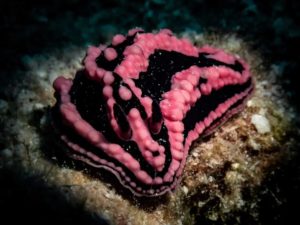
Up to 5 cm long, small ones about 1cm can be quite common on some shores. Body long, hard with bumps (called tubercles) that are clustered in groups. The bumps may be pink, red, grey, green or blue. There is a coloured margin around the edge of the body. The short rhinophores are black. There is no stripe along the underside of the foot. The black background forms more of a networked pattern. In other similar looking phyllid nudibranchs, the black background forms lines.
Scorpions Fish Families
STONE FISH
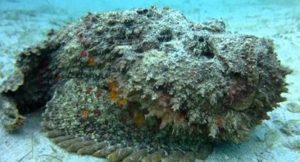
Stonefish are the most poisonous of all fishes. They are discovered throughout shallow seaside waters of the northern half of Australia. The fish generally lies motionless, typically partly buried in the substrate and completely camouflaged amongst surrounding rocky reef, coral, debris, or marine plants.The fish has 13 sharp strong dorsal fin spine that is included within a sheath of thick skin. At the base of each spine are 2 venom glands that release their contents along ducts in the spinal column. When interrupted, the fish erects its spinal columns, however keeps its position on the sea flooring. Stonefish has an overall length of around 47 cm, although 28 cm is very common. The Head, body, and fins are normally dark brown. The skin is warty, scaleless, and typically covered in a short coat of filamentous algae.Thirteen sharp dorsal spines are each consisted of in a thick sheath of skin. The head has deep pits and grooves. The eyes are little and positioned on a raised bony structure. The pectoral fins are fleshy and bigger.
LEAF FISH

**Taenianotus triacanthus**. The colouration of the Leaf Scorpionfish is variable, ranging from white, through pinks and reds to green. The species periodically sheds its skin. The Leaf Scorpionfish has a very compressed body and a sail-like dorsal fin. It has a variably developed ‘beard’ of fine appendages around the mouth. The colouration of the Leaf Scorpionfish is variable, ranging from white, through pinks and reds to green. They are well known for their weird looking shape with the venomous spine to protect themselves from predators. They can live 3 Years
DIABOLA FISH
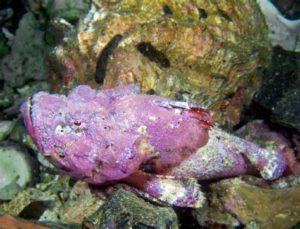
The Devil Scorpionfish (Scorpaenopsis diabolus) is also known as the False Stonefish. They are extremely well camouflaged and it can be hard to spot. As with all members of the scorpionfish family, they have poison glands for protection in their dorsal and pelvic fins.is a rather ugly unpleasant looking fish and its species name of diabolus which roughly means devil in Latin, is derived from its rather frightening looks. Their colouration is extremely variable and they take on the colours and textures of their surroundings. The skin is warty and full of small flaps. As they are immobile most of the time, algae and other organisms tend to grow on them adding to their camouflage. They have a typical Scorpionfish shape with a proportionally large head and mouth. They have a very distinctive hump shaped back which once one gets to know the shape of, helps to spot them. The pectoral fins are rounded and are colorful , resembling a fold out fan but are usually folded back with the bright colours concealed. The tail is small in comparison to the head and they are poor swimmers.
BARBATUS

Scorpaenopsis Barbata is a species of venomous marine ray-finned fish belonging to the family Scorpaenidae. This species is found in the Indian and Pacific Oceans.The bearded scorpionfish is definitely one of the strangest-looking fish in the sea. Its bizarre appearance serves to provide camouflage as it hides among the algae and seaweed on the ocean floor. When an unsuspecting fish swims too close, the prey is snapped up almost instantly with powerful jaws. The spines on the dorsal, anal, and pelvic fins secrete an extremely toxic venom that helps to protect the it from predators. The bearded scorpionfish can be found in the Western Indian Ocean from the Red Sea to the coast of Somalia.
WALKMAN
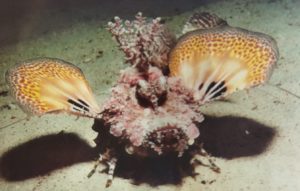
Member of the inimicus genus of venomous fishes, closely related to the stone fish. It can reach a body length of 25 cm (10 in) and is irregularly surfaced with spines and a knobby appearance. The fish has venomous spines to ward off enemies. The fish are nocturnal, and often dig themselves partially into the sandy seabed during the day. The body is red or sandy yellow and well camouflaged on sandy and coral seabeds.
LION FISH
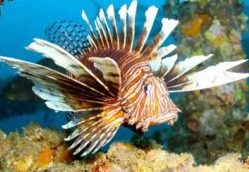
One of the best-known species is the Red Lion fish (Pterois volitans), an impressive fish sometimes kept by fish fanciers. It is striped with red, brown, and white and grows to about 30 cm (12 inches) long. Also spelled lion fish or lion-fish, also called turkey fish or fire-fish, any of several species of showy Indo-Pacific fishes of the Scorpaenidae (order Scorpaeniformes). They are noted for their venomous fin spines, which are capable of producing painful, though rarely fatal, puncture wounds. The fishes have enlarged pectoral fins and elongated dorsal fin spines, and each species bears a particular pattern of bold, zebralike stripes. When disturbed, the fish spread and display their fins and, if further pressed, will present and attack with the dorsal spines.
Ray Families
BLOTCHED FANTAIL
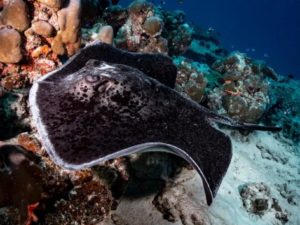
A very large stingray with a sub-circular disc that is very slightly wider than long. Snout short, and obtusely angular/broadly rounded, with a small, protruding apical lobe at tip. Anterior margins of disc convex. Pectoral fin apices broadly rounded. Pelvic fins very short.
Eyes small. Snout length approximately 2x combined eye and spiracle length. Mouth wide with 7 short oral papillae. Lower jaw convex. Labial furrows weak. Skirt-shaped nasal curtain short, wide, short fringe on posterior margin. Nostrils large and oval.
Disc covered in small granular denticles. Thornlets present in small patches on each shoulder and in a thin band along midline. Tail wide-based and short; slightly longer than disc width. Tail tapers to caudal sting then thin to tip. Ventral finfold extends to tip of tail; finfold height 2-3 x tail height posterior to caudal sting. Dorsal finfold absent. One caudal sting usually present.Tropical seas and warm-temperate seas. On sandy substrates, reef rubble, rocky reefs, and in caves.
EAGLE
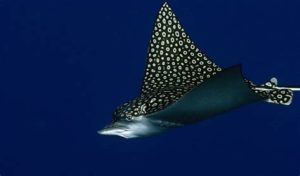
These energetic, charismatic, and large members of the stingray family are incredibly interesting. They differ greatly from other stingrays, and with approximately two dozen different species, there’s so much to learn.
- Breach! – Many species in this family are known to acrobatically breach, or jump out of the water. Like a number of whale species, scientists are unsure of the exact purpose of this behavior. They speculate it is similar to the reasons whales may breach; to knock off parasites, to communicate with one another, or for breeding purposes.
- Crunch Time – Like other stingray species, eagle rays have flat plates rather than typical teeth. They use these plates to crush crustaceans like crabs, clams, shrimp, and more.
- Shovel Nose – Some species, like spotted eagle rays, will use their flattened snouts to dig in sand or mud. Oftentimes their prey is buried in the sand, and this aids in dislodging and capturing it. They can also spew sand from their gills to create a cloud to confuse their prey, or potential predators.
- Flap Along – These creatures swim in an entirely different fashion than other rays. While most stingrays swim using an undulating motion with their fins, eagle rays are much more efficient. They flap their triangular wings up and down. This makes them much more agile than other members of the ray family.
PORCUPIN
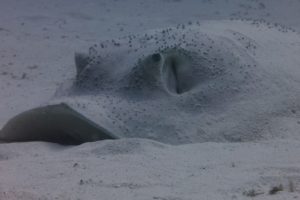
The Porcupine Ray has an oval-shaped disc that is covered with plate-like tenticles and sharp thorns. The tail lacks stinging spines and skin folds. The fish is brown to grey above and white below. The tail tip is dark.The porcupine ray reaches a maximum length of 4.8 feet (1.5 m).Has a very thick, tall body with thin wings that complete its oval appearance.Skin is armored with strong dermal denticles, varying from flat to pointed and thorn-like.Displays countershading, being grey or spotted above and very pale or white ventrally. The tail is thick and lacks a venomous barb.Ovoviviparous; eggs hatch internally and are born as live young
“Vulnerable”
FEATHERTAIL
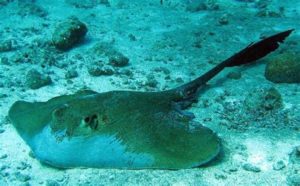
Up to 180cm . Depht 1-60m. General this species is found near coral reefs and lagoons, also in fresh water. It’s of uniformly brown coloration except for a clearly distinct large lobe of skin on the posterior half of the tail, witch is more darker. A sting is located on the tail fin lobe. Feeds on shelled molluscs and crustaceans. Inquisitive, investigating divers’ activities and often accompanied by pilot fish.
BOWMOUTH GUITARFISH

Up to 240cm, The Bowmouth Guitarfish has large pectoral fins – like a ray. But their body tapers in at the back, becoming more streamlined, and ends with a powerful tail – like a shark. Yet because their gills are positioned on the underside of their body, they’re classified as a ray. One of the most distinctive features of the Bowmouth Guitarfish is their broad round snout, which is shaped like a bow – thus its name. Dark bands are visible between their eyes and spiracles (‘breathing’ holes that sit behind the eyes). They have bony ridges above their eyes, giving them a prominent set of “eyebrows”. And these are truly formidable, containing a row of defensive spiky thorns! It’s thought that they may use these to head-butt potential predators.
SPOTTED SHOVELNOSE
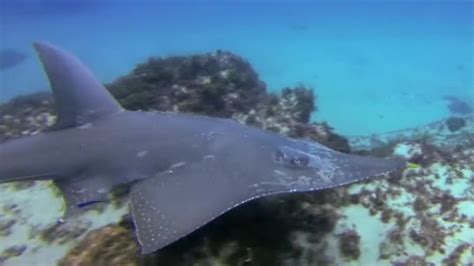
Up to 310cm Depth 2_50M. Similar to the species, but slimmer and more flattened like a typical ray. Largest Guitarfish, common on sand, sometimes seen in extremely shallow water.It is ovoviviparous with litters of up to 10 young, wich are born in estuaries or mangrove areas. Feeds on invertebrates or benthic fishes.
Shrimp Families
MANTA SHRIMP
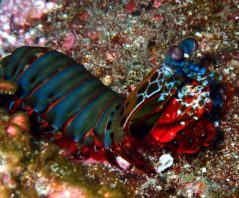
Peacock Seychelles are elongate crustaceans characterised by a very short carapace , only 3 pairs of walking legs and a long flatened tail. Most conspicuous is a pair of praying mantis-like raptorial claws, folded under the sides of the carapace. Manta Shrimp are living solitarily in simple burrows with two opening. They hunt from the burrow or leave it to forage.
BANDED BOXER
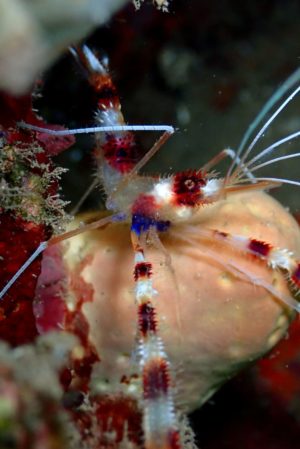
Up to 5cm, a common cleaner shrimp with spiny, bristly body and chelipeds. The base of chelipeds is blue. The specie is always found in pairs. Male are smaller. They establish territories which they advertise as a cleaning station. Banded Boxer Shrimp will attract ‘clients’ by waving their white antennae and red and white banded claws. These shrimp will scour fish and other marine animals for any parasites attached to the animal’s body and even inside the mouth, as well as clean away dead tissue. The fish benefits through having potentially harmful parasites, like sea lice, removed and the shrimp gets a tasty meal in return. Fish and other marine animals will actually wait in queues for the cleaning services of these attentive crustaceans! Cleaner shrimp are rarely preyed upon by their clients, proving their worth in the coral reef community.
HARLEQUIN
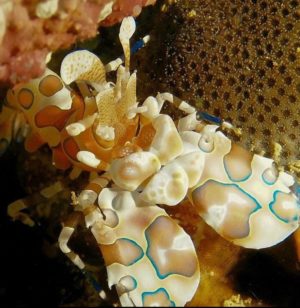
Is a species of salt water shrimp found at coral reef in the tropical Indian and Pacific Oceans. They reach about 5 cm in length, live in pairs, and feed exclusively on Starsfish including crown of thorn starfish. Harlequin shrimp is usually cream colored or white with occasional spots. Around the Pacific Ocean, many of these shrimp have red spots, while the Indian Ocean shrimp typically have purple spots; Its body usually reaches up to 5 cm (2 in), and the male is slightly smaller than the female.
DURBAN DANCER
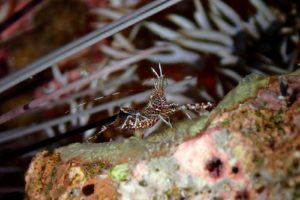
Up to 4cm. It lives deep in crevices and holes, usually in large numbers.Large bulging eyes and the humpback are obvious are morphological characteristica that differentiate members of this family from other decapods. We call them durban dancer because of their unusual way of moving on the ground. They strut around carefully, only to pause after a few moment.
AngelFishes Families
BLUE DWARF
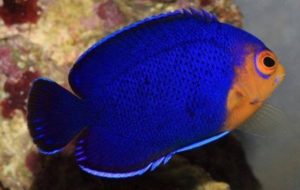
Up to 9cm. Known only from Mauritius , Reunion and Seychelles since 1998. Depth : 15-90m. Generally is found in deep water.Generally speaking, all dwarf angels can be kept in a reef tank and having live rocks is the best environment for them in terms of shelter and foraging. Only a single specimen was observed
EMPEROR Adult
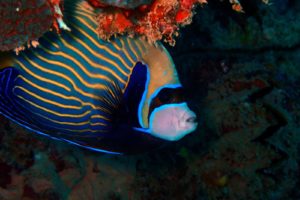
Up to 40cm, the adults exhibit alternating yellow and blue horizontal stripes on their sides; white, black, and yellow coloration around the head (including a “raccoon mask” across the eyes); and a bright-yellow tail fin. They live singly or in pairs.
EMPEROR Juvenile
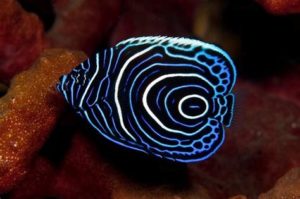
They have a dark blue to black base color with light-blue to white lines forming vertical stripes and concentric circles on their flanks. They live singly and secretively
ROYAL
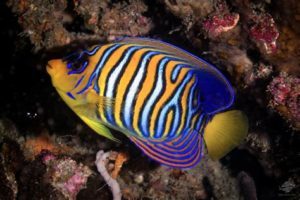
Up to 25cm. Depth 1-48m. Unmistakeable species found singly, in pairs or uncommonly in small groups in areas of rich coral growth on seaward reefs. They greatly prefers an area naturally rich in coral growth, both inside and outside the reef, and at depths from knee deep down to 40m . This fish greatly prefers to stay near areas with plenty of cracks, crevices, and caves where it can quickly hide from any perceived threat
KORAN

Up to 40cm. Adults occur in coastal reefs with a rich coral growth. Generally solitary, feeds on sponges. They are often found swimming in pairs, up to 30m below the ocean’s surface. These fish predominantly feed on algae and tunicates , which are abundant in the coral reefs that serve as their native habitat.
BOXFISHES FAMILIES
CUBE (Female)
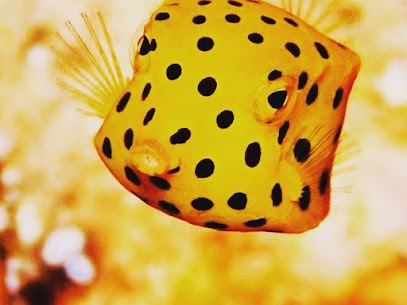
Up to 45cm , Female are bright yellow with black spots nearly as large as the pupil becoming more elongate with age. Solitary specie always seeking shelter under overhangs in the reef.
CUBE (Male)
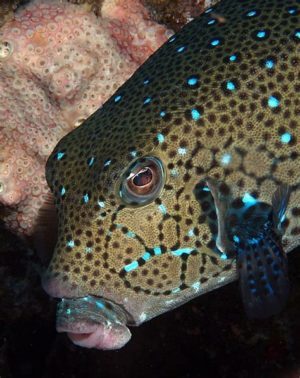
Up to 45cm, are variable in colour ranging from ochre to purplish brown the rounds spots on the carapace of the smaller female phase being more or less prominent
THORNBACK
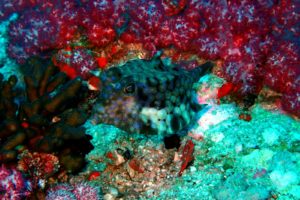
Up to 15cm, singly or in pairs, over coral rubble and sand with coral spatches. As with most boxfish the Thornback cowfish is quick to hide in any convenient hole or hiding spot when approached and will often turn once in its hiding place, hovering in position to view the diver. They usually swim low on the substrate and often hide in soft corals when they see a diver.
WHITESPOTTED
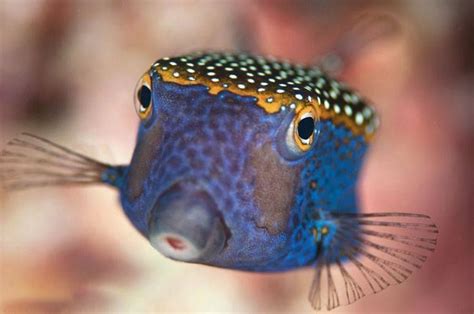
Up to 16cm. It’s a small fish that isn’t fast and doesn’t use camouflage. Instead, its bright colours warn potential predators that it’s poisonous to eat. It’s a cousin of pufferfish, and can inflate its body when threatened, adding to its defence.
PUFFERFISHES FAMILIES
VALENTIN
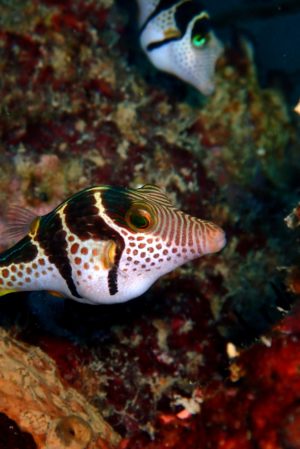
Up to 10cm, He is highly poisonous to eat. Dominant males breed exclusively with the females in their territory and maintain territorial boundaries. Females can lay anywhere between fifteen to 800+ eggs at a time every four to ten days. After eggs are laid, no parental care is required because eggs are unpalatable and, thus, reasonably safe from predation.
STARRY
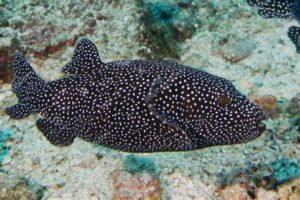
Up to 50cm, swims occasionally with others puffers. To top the list of defensive mechanisms of these slow-moving fishes are all poisonous: skin and reproductive organs contain the lethal tetrodotoxin.
MAPPA
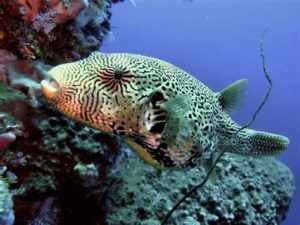
Up to 65cm, Feeds on meaty foods such as: chopped squid, scallops, and krill. Will feed on crabs, hard shelled shrimps, and small fish. Their intelligence in action as they observe a situation and seem to consider various courses of action before deciding what to dot.The larger puffers have voracious appetites.
ANGLERFISHES FAMILIES
GIANT (Frog)

Up to 33cm, He is can be yellow, black, green, brown or orange.A large well-camouflaged anglerfish that matches colour of sponges on which it lives. Individuals range from shades of yellow to brown, although white, pale yellow, tan, pink, red, green and black fish have been seen. Giant Anglerfish often have low, warty projections on their bodies, and the ‘fishing lure’ is a small tuft of flattened appendages.
CLOWN (Frog)
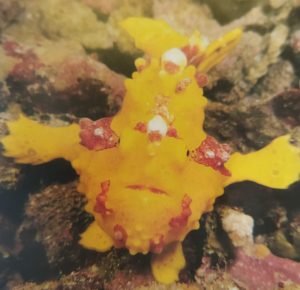
Up to 40cm, usually yellow with red saddle-like blotches and wart-like swelling all over body and fins. The strangest-looking fish is probably the clown frogfish. Their strange facial features and weird looks can give you a negative impression of them. However, you would be surprised to know how fascinating they can be.The anglerfish’s diet should consist of meaty table seafood such as shrimp.Females spawn thousands of tiny eggs inbeded in a large gelatinous mass.Depending on their species, you would also find them in both shallow and deep water. They live by eating small animals. However, clown frogfish can’t chew because they don’t have teeth. That’s why they swallow the whole animal. They are extremely solitary and only find a mate during the mating process.
SHARK FAMILIES
NURSE SHARK
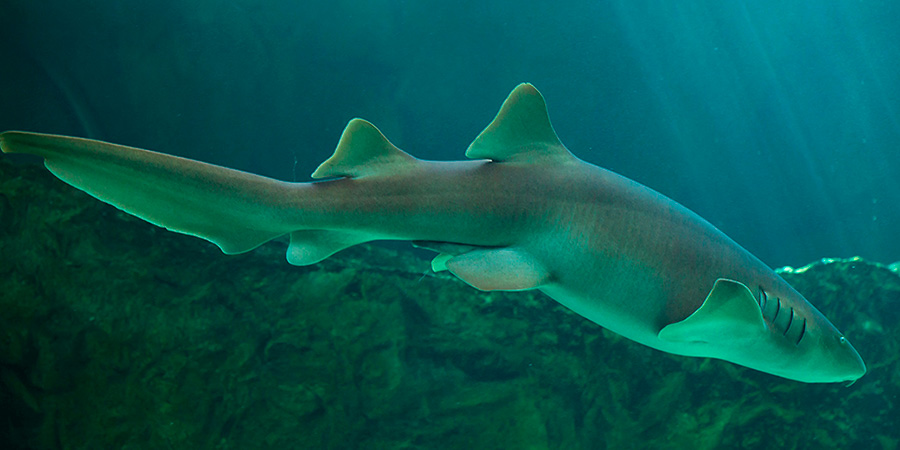
Up to 300cm, a noctturnallyactive,bottom-dwelling shark species,hiding in caves by day, often seen in groups. Its coloration uniformly brownish yellow without any pattern. A pair of barbels extending from the inner margins of the nasal openings above the mouth. Nurse Shark’s prey of crustaceans, reef fishes.The gestation period is 5 to 6 months and this species is ovoviviparous, meaning that the eggs develop in the female’s uterus and hatch there before delivery. Nurse sharks have litters of around thirty baby sharks.
COMMON TRESHER SHARK
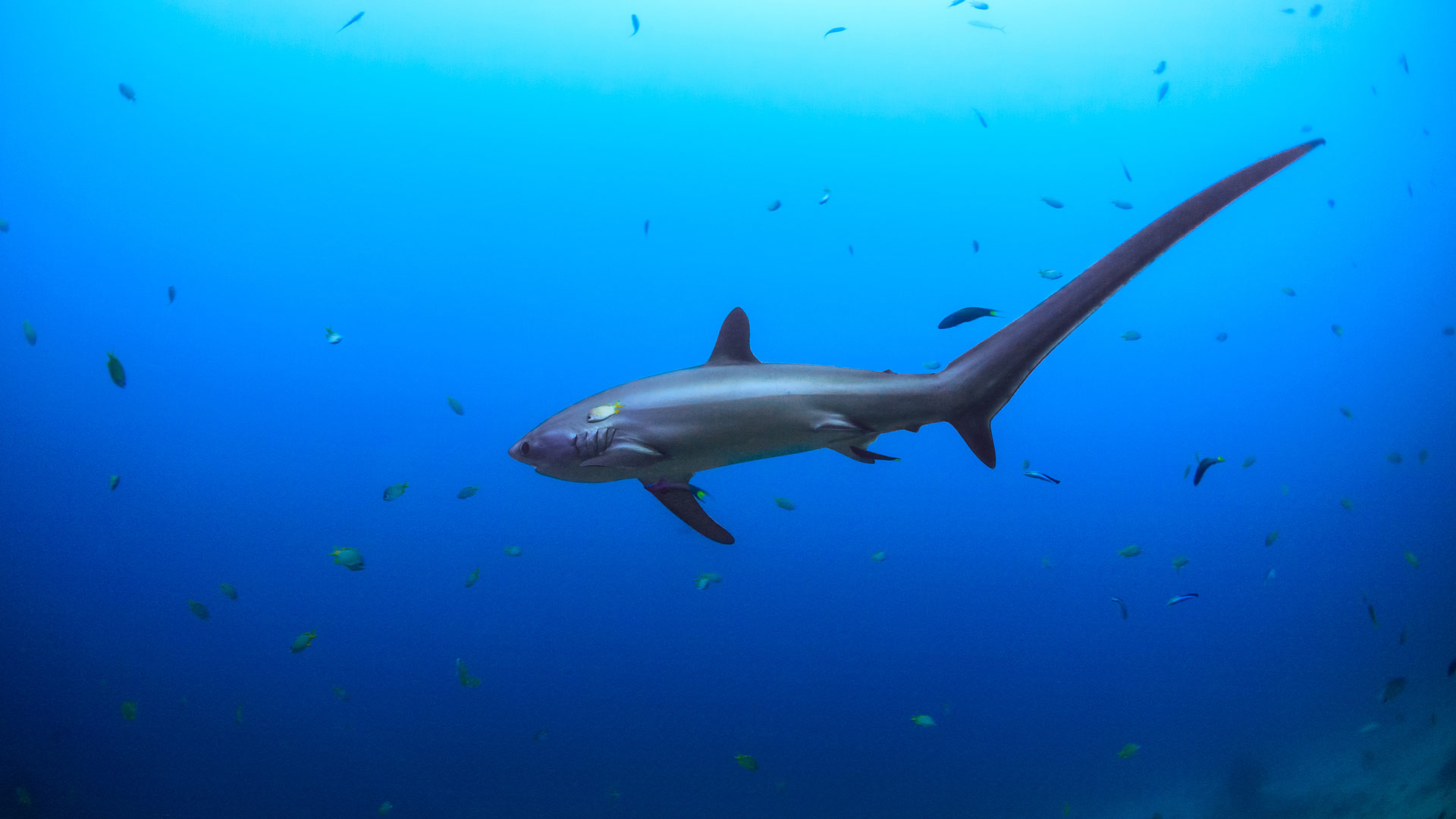
Up to 330cm, an unmistakable species with a very long caudal fin that it used to stun schooling fishes, the main prey of this timid shark. It also feeds on schooling shrimp and squid. The Thresher shark lives pelargically and is only rarely encountered in coastal waters. Reproduction is ovoviviparous with a litter size of two.Thresher family shark comprises 3 species, all of which occur in our area. They are not easy to distinguish.
BLACK TIP SHARK

The animal frequents bays, estuaries, coral reefs, and the shallow waters off beaches and river mouths. During summer some blacktip sharks migrate to typically cooler waters. Blacktip sharks supplement their diets with skates, stingrays, squids, and some crustaceans. These sharks have also been known to follow fishing boats and feed on discarded bycatch.Blacktip sharks are viviparous,gestation takes 11 to 12 months.
